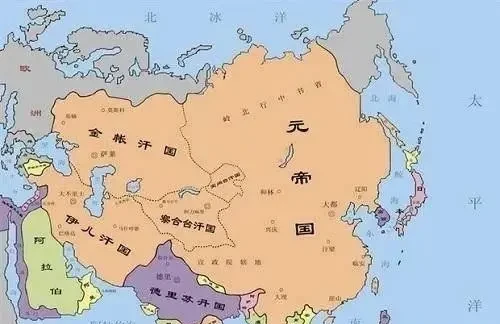I learned the story of Wobashi's return to the east, and now some people want to know whether Wobash is a descendant of Genghis Khan, and I have to spend a little ink on this issue to explain it well.
In the 13th century, the rapidly rising Mongol tribes in the Mongolian steppe, under the leadership of Boerjin Temujin (later known as Genghis Khan), swept across eurasia, conquered a large number of land and population resources, and in 1206, established the world's super empire, the Great Mongol Khanate.

After genghis Khan established the country, in order to consolidate his wealth and divide his family property according to the customs of the Mongols, he divided his five brothers and four sons into large and small "Ulus" (Mongolian Khanate), gave them land and population, and managed the vast country for him. At that time, there were four major khanates with the largest land and population: the Chincha Khanate (also known as the Golden Horde) established by the eldest son Shuchi and his descendants, the Chagatai Khanate established by the second son, the Wokoutai Khanate established by the third son, the Ilkhanate established by the fourth son Torre and his descendants, and the Khanate of the Great Khanate. Soon after the death of Genghis Khan and his grandson Möngke, these four khanates were caught in a war for the khan's throne, and when Kublai Khan destroyed the Southern Song Dynasty to unify the Central Plains, the four khanates were basically free from the control of the Great Khanate (the area ruled by the Yuan Dynasty) and became independent.
Subsequently, there were constant wars between the Mongol khanates, the four khanates and the Yuan Dynasty, and the Mongol forces that once traversed Europe and Asia completely declined.
After the Ming Dynasty, the Mongol tribes withdrew from the Central Plains, fled into the desert north, and survived in Mongolia, north and south of the Tianshan Mountains, coexisting with the Ming Dynasty regime for a long time, mainly in the Tatar, Valla, and Turpan Khanates. He briefly unified the Mongol tribes on the Mongolian plateau, but he was not accepted by the Golden Family (descendants of Genghis Khan). Also after his death, the Wallachia split into four divisions: Dzungar, Heshuot, Durbert, and Turgut.
At the end of the Ming Dynasty, the Dzungar clan was strong, and the turk chieftain and the Dzungar chief were not in harmony, so with the tuergut chieftain, some of the Durbert and Heshuo tribes totaling 190,000 people moved west across the Mongolian plateau to the lower volga river, where they reclaimed the land, grazed their cattle, and survived.
After the sixteenth century, the Slavs of the Golden Horde (most of present-day Russia) began to rise, and they invaded the Turks living areas with the Cossacks, constantly squeezing the living space of the Turks, and the Tsarist government has always regarded Turgut as a thorn in the side. In the middle of the 16th century, after the Tsarist Russia occupied the Kazan Khanate, the Astra Khanate and the Nogai Khanate by force, it then extended its claws to turks and Mongolia. The Turks were forced to fight for Tsarist Russia and became instruments of the Tsar's aggressive expansion.
Faced with the threat of aggression by Tsarist Russia, several generations of Turgut Khans did not succumb to the tsarist russia's obscenity, but waged a resolute struggle. Consider yourself "entitled to nomadic pastoralism in the steppes, to sail in rivers" because "the land and water are of the Buddha", and to bravely say "no" to the invaders.
After succeeding to the Khan's throne, Wolbasi was not willing to continue to endure the persecution and oppression of Tsarist Russia, and in the first month of 1771 AD, he led 170,000 tribesmen across the Kazakh steppe to return to the east, and arrived in the Ili region of Xinjiang in May of the same year, when there were less than 50,000 or 60,000 people left in Turbat.
The hero of the East Return, Wolbassie
After the return of Wolbasi to the east, the Qing government sent people to distribute agricultural tools and seeds to the Turbats, and made proper arrangements in the northwest region. He also brought Wolbasi to Beijing to study the imperial court regulations in order to better manage the clan.
Speaking of which, we can say with certainty that Wobasi is the most heroic descendant of Genghis Khan. His actions of resisting the oppression of Tsarist Russia and returning to his homeland in the East made it clear to posterity: Only when the motherland is strong, the people will not be bullied by foreign nations, which is the truth that all Chinese should understand the most!